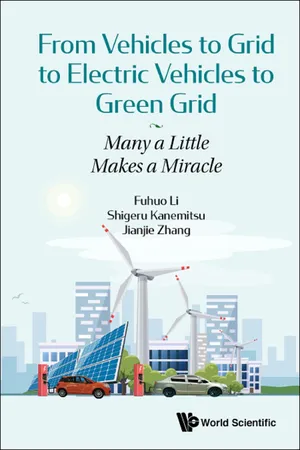
From Vehicles to Grid to Electric Vehicles to Green Grid
Many a Little Makes a Miracle
Fuhuo Li, Shigeru Kanemitsu;Jianjie Zhang
- 232 pages
- English
- ePUB (mobile friendly)
- Available on iOS & Android
From Vehicles to Grid to Electric Vehicles to Green Grid
Many a Little Makes a Miracle
Fuhuo Li, Shigeru Kanemitsu;Jianjie Zhang
About This Book
This book paves the way for a proper understanding of current and future issues on global warming, air pollution, depletion of natural resources, cyberattacks on smart grids, amongst others, by unifying various diverse disciplines of science to focus on a sustainable green society of the future.
Readers will find applications of science described through the practical use of mobilities, in this case, the electric vehicles.
The book could be used to teach and study on issues of global warming through the window of electric vehicles. The first three chapters can be used for teaching applications of mechanics, quantum mechanics, thermodynamics, and fluid mechanics. Chapter 5 provides rudiments of control theory in anticipation of control theory through number theory and algebraic geometry. Chapters 6 and 7 contain aspects of climatology, global warming, and electric vehicles to green grid. This is the only such comprehensive introductory book in the market that provides the readers hints, suggestions and directions to ponder for a sustainable future through renewable sources.
Contents:
- From Mechanics to Quantum Information
- Thermodynamics in Engine Principles
- Fluid Dynamics: Navier–Stokes Equation
- Control Theory
- Aspects of Chemistry: Adaption Principle
- Climate Change and Carbon Circulation
- EVs in Green Grid
- Signal Restoration: From Paley-Wiener to Abel Continuity Theorem
Readership: Undergraduate and graduate students, and researchers interested in the practical use of mobilities for a sustaninable green society. Electric Vehicle;Control;Signal Restoration;Adaption Principle;Global Warming;Navier–Stokes Equation;Quantum and Classical Mechanics0 Key Features:
- It covers both the fundamentals and the practical aspects of applied fundamental sciences and so it can serve for multi-purpose use
- Skipping over the mathematics, the book gives the general reader an idea of the main issue in the global concerns and so is well suited for graduate students and researchers in academia, government laboratories, and industry
- It gives hints for further self-study and reading to confront the problems for the concerned reader
- The book shows the directions, from the author's viewpoint where the world is heading as far as global warning is concerned
Frequently asked questions
Information
Chapter 1
From mechanics to quantum information
1.1Newtonian mechanics






